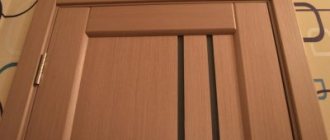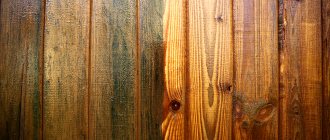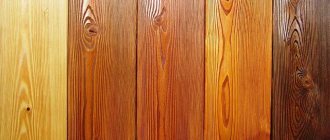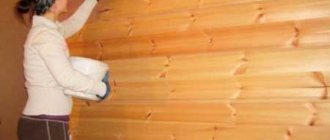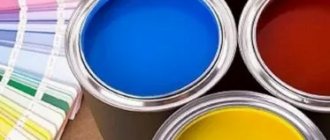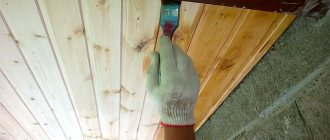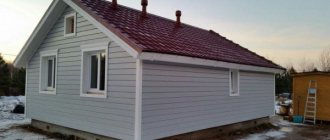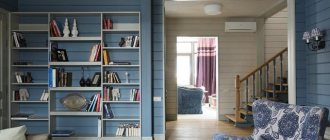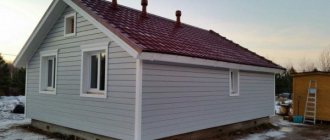Wooden lining is a beautiful, natural material. It is not surprising that so many users around the world prefer it as a finishing and facing material.
The environmental friendliness and natural beauty of wood not only decorates the room, but also creates a certain microclimate in it. And the lining covered with a thick coating (paint, varnish) allows you to create any decor.
But wood has a significant disadvantage that affects the performance characteristics of the lining - it is subject to rotting, various damage, and also tends to darken.
This article is intended for those who want to protect and at the same time preserve the lining in its natural form. Let's consider step by step how and what is the best way to coat (impregnate, treat, paint) wooden lining (euro lining).
I must say that the “take a brush, paint and paint” method is good precisely because of its simplicity. But how long will wood painted this way last? Wouldn't it be better to take a more thorough and correct approach?
Proper painting of wooden lining consists of 4 stages:
Tips for choosing a finishing coating for wooden lining
- color . Since stain or paint changes the color or shade of the lining, you need to use this property. For example, light shades visually increase the space. The use of different colors/shades allows you to zone the room;
- compound . The prefix “bio” after the name of the varnish indicates the absence of harmful substances. This composition can be used for interior work;
- manufacturer . Many domestic analogues of lining varnish or paint can create worthy competition for foreign goods. At the same time, the price of the product will be more humane.
How and with what to paint the lining in the bathhouse and steam room
Wax composition Evrotex-Sauna for lining in a bathhouse Due to the high temperature, it is better not to paint the lining in a bathhouse, but to treat it with protective compounds.
An excellent solution would be to use wax compounds, for example, Evrotex-Sauna. This coating is suitable for use in conditions of high temperature and cyclic intensive humidification.
Advice. You only need to apply the varnish once in the sauna. In the dressing room - you can make several layers.
How and with what to paint the lining on the veranda
The veranda or terrace is exposed to the greatest influence of atmospheric factors, so the material must be resistant. First coat with a layer of primer, and then 2-3 layers of varnish or paint.
How and with what to paint the lining inside/outside the house
There are no particular differences in painting a house outside or inside. The only difference is in the coatings used. Varnish/paint for interior work must meet environmentally friendly requirements. For outdoor work, it is more important that the coating can withstand moisture, temperature changes, and exposure to UV rays. The same type of paint can be used inside and outside a building. The difference is in the number of layers applied.
How to paint lining correctly - tool
To paint the lining you can use:
- brush. They are convenient because they allow you to paint wood in corners and hard-to-reach places. The paint is applied most evenly with a brush;
Advice. To apply the paint with a brush evenly and avoid smudges, you need to immerse the brush halfway in the paint.
- roller Allows you to paint quickly. However, to obtain a uniform layer you need to paint several times;
- spray. Allows you to get the job done as quickly as possible. But it increases paint consumption;
- mitten (chain-shaped). It is convenient to use a glove to paint (impregnate) the places where the lining joins (frames) the pipes;
- foam sponge.
Impregnations
These compositions are distinguished by the fact that they penetrate deep into the structure of the material and do not create a film on the surface. Some of the solutions discussed below can be used as a full-fledged protective layer, others can only be used as preparation for finishing.
The most popular options are:
- Stains give the surface a certain shade, but do not protect it from water and other influences. The compositions can be water-based, alcohol-based or oil-based. They differ in properties, but perform the same function. The choice depends on the specific conditions, but the most popular are water-based solutions; they are distinguished by their low price and safety;
Before covering the lining with stain, you should choose the desired color
- Acrylic-based impregnations are often called glazes. They differ from stains in that they tightly close the pores of the wood, so they can also be used as a finishing finish. If you are thinking about how to cover the lining to prevent it from darkening, then this option will come in handy. Acrylic emulsion reliably protects against ultraviolet radiation, and the surface retains its original color for a long time;
If you are thinking about how to cover the lining outside the house, then choose acrylic compounds with wax, they are especially reliable
- How to cover the lining outside the house or inside the premises to protect them from mold? Antiseptic compounds provide excellent protection against fungus and extend the life of wood significantly. Such solutions are used exclusively as a preparatory layer; the surface is always covered with something again;
Antiseptic impregnations can tint wood to the desired color
- If you are thinking about the best way to coat eurolining in order to increase its resistance to fire, then the best option would be special fire retardant compounds. They also serve as a preparatory layer before the main coat. A universal fire-bioprotective solution can be an excellent solution; it makes the material resistant to both fire and mold.
Universal formulations are very popular
Choose products from well-known manufacturers. You won’t be able to check its quality by eye, so it’s better to consult to find out which formulations have proven themselves best.
Wood paneling painting technology
- Before painting or applying varnish/paint, they must be mixed well. This way they will lie more evenly;
- a test paint will allow you to understand what the painted surface will look like;
- It is better to apply the paint in several thin layers. This way, each layer will dry faster and the coating will be applied more evenly;
- the next layer of paint/varnish should be applied only after the first one has completely dried;
- When painting the lining, you need to leave gaps of 2-3 cm at the top and bottom of the panels. This will allow the tree to breathe. And the gaps themselves can be closed with decorative plinths;
- to avoid obtaining different shades of wood, it is better to paint with paint at a time, using material from one batch;
- if there is a need to interrupt work, try to make sure that the “seam”, the border of the painted and unpainted area, is not in a visible place;
Tips for storing an open can of paint:
If work is interrupted for a long time, then in order to prevent a film from appearing on the surface of the paint, you can put cardboard impregnated with drying oil on the surface.
If a film appears, its particles may fall on the surface to be painted. In this case, it is better to cover the surface with foam rubber and dip the brush through it.
- a more saturated color/shade can be obtained if you apply the paint several times (up to 4). Further increasing the number of layers will have no effect;
- Do not allow paint/varnish to dry too quickly. This may cause the painted layer to crack. Professionals do not recommend applying paint/varnish in direct sunlight.
Paints
This type of product differs from the ones described above in that an opaque film is created on the surface. Therefore, if you need to get a specific color, then this option is perfect.
Paint allows you to give the lining any color
There are also many composition options; before covering the lining in the house, you need to choose a specific solution:
- Oil paints are a traditional option that is being used less and less these days. The composition has good protective properties, but it is short-lived; after a year or two, the coating needs to be renewed. Another disadvantage is the small selection of colors;
Oil paints are rarely used
- Alkyd paints are very popular because they adhere very well to the surface and do not lift the fibers of the material. The composition is distributed in a thin layer and forms a durable film that protects well from moisture and has good wear resistance;
This option has a much wider choice of colors.
- Acrylic compositions make it possible to create an attractive and durable coating for eurolining. They are absolutely harmless, which allows them to be used in premises for any purpose. The paints are water-based and come in a huge variety of shades. You can simply buy white composition and pigments and create your own unique color.
Acrylic compositions retain the brightness of colors for a very long time
Types of paints and varnishes for woodworking
Priming
Antiseptic primer - this composition is not just a full-fledged primer, but also a powerful bioprotective agent. It can be used for.
Its use is recommended by the manufacturer even for damaged wood. If the product is used together with protective texture coatings, it will extend their service life and give the wooden structure a noble, well-groomed appearance.
Protective and decorative coatings
This is a relatively new product in the paint and varnish sector. When using protective and decorative coatings, the surface is painted in the desired color or shade.
At the same time, the natural texture of the wood is completely preserved. In addition, the use of this product does not require preliminary priming, since it already contains antiseptic components.
Some modifications of decorative coatings can be used to work with damp wood (up to 40%). Such compositions are perfect for both interior and exterior decoration.
The final coating has soft semi-matte tones. These compositions are resistant to fading and temperature changes. So for the next eight years you will not need to treat the lining inside the house. In any case, this is the guarantee provided by the manufacturers.
Scuba diving
Advantages of the composition:
- Odorless;
- Short drying interval between layers;
- The composition does not use organic solvents;
There are also compositions with water-repellent additives; they can give the wooden surface dirt- and water-repellent properties. The price of protective equipment with such components is slightly higher than usual, but the costs will be justified by a long service life, ease of maintenance, and a dry and clean surface under all conditions.
Oils
Treatment of wood with oils and their combined compositions is considered a fairly promising direction.
When applied, the oil penetrates deeply into the structure of the wood, thereby reliably protecting it from harmful effects:
- moisture;
- mud;
- house dust.
When working with oils, there are completely no sharp odors of solvents; only the aroma of the plant whose oil is used is felt in the air.
The treated surface acquires a golden hue. Oils are easily tinted and, if desired, you can get a coating of any color.
Tools for painting operations
We answered the question of how to treat the lining, but there was one more question: how to treat the lining inside the house?
Its importance lies in the fact that all compositions are different in consistency, so you should pay special attention to the selection of tools so that applying the protective layer is convenient and effective.
An approximate list of what is needed when applying paint and varnish mixtures:
- Napkins
- Construction tape
- Scotch Brite
- Sandpaper (#240)
- Tray for paint or varnish
- Roller
- Brushes
Whitening
This process is the first step when painting with any composition.
It involves cleaning the boards from any contaminants.
If there are difficulties with selecting bleach, then it is best to use a special stain.
After the bleaching process is completed and the lining becomes a clean canvas, you can proceed to the second stage - priming. The third stage is applying paint.
Tools needed for whitening:
- Roller
- Tassels
- Stain (bleach)
- Solvent
- Gloves
- Eye protection glasses
Video - glazing of wooden surfaces:
We paint according to the rules
If the wooden surface has already been painted several times, then before applying a fresh layer of varnish, it is necessary to evaluate the quality.
If it is still good, then you can wipe it with a 2% soda solution.
To prepare such a solution you need 10 liters of heated water and 300 grams of soda.
After treatment with soda solution, the working surface should be puttied and treated with drying oil. After this procedure, all wooden surfaces in the house will be significantly transformed.
If painting the lining inside the house is the first time, professionals advise adhering to a certain technology in this matter in order to avoid smudges and unevenness.
Paintwork products should be applied using bristle tips. It is very important that it is thin. Otherwise, a large amount of paint may become unusable. To prevent the lint from leaving a mark on the walls and ceiling being treated, it is better to treat them with a soap solution before starting painting.
Video - how to properly treat the walls inside the house: Particular care should be taken when applying the final layer. To ensure an even coating, it is best to start applying the protective composition from the top. Hard-to-reach places, for example, frames, baseboards, and the space near radiators, are best painted with a brush that has a diameter of no more than 5 cm.
It is best to start painting the door from the paneled side.
A dry brush will help prevent paint smudges. Upward movements of the brush will remove unnecessary imperfections from the surface.
Video - painting the inside of the house:
Cost of work
The price of painting lining per square meter is approximately 280 rubles.
One square meter of the lining itself will cost the buyer approximately 320 rubles. But the cost of the boards is significantly influenced by the wood from which they are made and its grade.
Varnish for treating wood can be bought for approximately 260 rubles per liter.
We hope that this article will help every owner paint the lining with high quality, as well as choose the right materials. Good luck with your work.
Application
To renew the wall covering, you need not only to know how to remove varnish from the lining, but also how to use the coatings correctly. To begin with, the walls (floors, ceilings) are washed; for this, take a damp cloth with special cleaners for wood. This is necessary to remove dust and dirt from the wood pores.
Next, the old coating layer (if any) is removed or the lining is sanded. For this purpose, both special grinding machines and low-abrasive sandpaper and metal brushes are used. This is necessary to level the surface and eliminate nicks. After this, you need to paint the wood with drying oil. It can be bought at any hardware store. The drying oil will fill microcracks in the lining and help improve adhesion; after the drying oil has dried, a primer is applied to the walls.
How to paint lining with varnish:
- Movements should go along the tree structure, preferably from top to bottom. The first layer is made dense, but without streaks;
- For painting, you can use both brushes and rollers, but it is more convenient to work with brushes. The material of the working part of the instrument must be made of natural wool;
- Experts recommend doing 3 layers of varnish, the last being the thinnest. It is leveling. Afterwards the room is left to dry and ventilate. Once every 3 years, the coating will need to be renewed to avoid cracks and chips.
You can buy varnish for lining at any hardware store; on average, the price varies from $6 per can. The cost may vary depending on the brand and purpose of the product.
1 September 2015
- What varnishes exist today?
When choosing a coating for the interior decoration of a house, people increasingly give preference to natural materials, such as lining. Well-processed panels made from various types of wood are not only beautiful, they are environmentally friendly, have a subtle aroma of wood, and are ideal for creating a cozy atmosphere in the home.
It is necessary to varnish the lining immediately or a few days after its installation, using a waterproof varnish.
Its undoubted advantages include excellent heat and sound insulation, ease of installation and subsequent maintenance, long service life, the ability to aesthetically cover construction flaws (uneven surfaces), cables and electrical wires.
Lining is used for finishing a wide variety of surfaces: floors, ceilings, walls.
There is a lot of information about how to install it. But not all sources indicate that it is necessary to varnish the lining to extend its service life and maintain a beautiful appearance. It would be useful to protect the natural coating from a variety of pests, mold, mildew, moisture and even sunlight.
How to carry out the work correctly
Once you have chosen a specific option, you can get to work. Instructions for applying the composition yourself are as follows:
- Before covering the lining inside the house, you need to stock up on the required tools. You can apply paint or impregnation with a brush, with a roller, or with a spray gun. You will also need a brush to clean the surface, a ladder to reach the top; if you are painting the ceiling, it is better to take a table;
- Next you need to prepare the surface. To do this, you need to clean it from dust and debris. If there are stains on the wood, they should be removed. It is unacceptable to work on wet substrates; if the material has not dried completely, then painting cannot be started;
- Covering the lining with the composition is done in different ways. If you do the bulk of the work with a roller, then the seams are painted over with a brush afterwards. If you work with a brush from start to finish, then you can go in order. The composition must be distributed in an even layer, the formation of smudges is not allowed, for this reason it is better to paint from top to bottom, then all the flaws will be removed;
If you work with a spray gun, do not forget to stock up on protective equipment in advance: goggles, a respirator and a suit. During operation, a lot of small splashes are generated, and it is undesirable to inhale them.
- In order for the coloring quality to be as good as possible, you need to apply at least 2, or even 3 layers. Some, before covering the lining with paint or varnish, impregnate it with an antiseptic. But even in this case, the decorative coating is applied twice, this allows you to achieve a rich color and durability of the coating.
The question is often asked, how to renew varnished lining? There are two options: if the surface condition is good, then you can go over the layer with fine sandpaper and apply a fresh coat of varnish. If the lining is darkened or damaged, then it is better to repaint it; to do this, use a composition on the same base, then it will fit perfectly.
Bottom line
Having information about the characteristics of a particular composition, you can easily decide how to process the lining inside the house. And when purchasing paints and varnishes, do not hesitate to ask the seller for a quality certificate from the manufacturer. After all, high-quality protection of a wooden surface is the key to its long service life.
Wooden lining is a beautiful, natural material. It is not surprising that so many users around the world prefer it as a finishing and facing material.
The environmental friendliness and natural beauty of wood not only decorates the room, but also creates a certain microclimate in it. And the lining covered with a thick coating (paint, varnish) allows you to create any decor.
But wood has a significant disadvantage that affects the performance characteristics of the lining - it is subject to rotting, various damage, and also tends to darken.
This article is intended for those who want to protect and at the same time preserve the lining in its natural form. Let's consider step by step how and what is the best way to coat (impregnate, process, paint).
I must say that the “take a brush, paint and paint” method is good precisely because of its simplicity. But how long will wood painted this way last? Wouldn't it be better to take a more thorough and correct approach?
Proper painting of wooden lining consists of 4 stages:
Types of varnishes for working on wood
If we talk specifically about how to treat the lining in the house, then the choice of protective mixtures is quite large.
1. Soil
This mixture is not only a complete primer, but also an excellent bio-protective agent. Primer – antiseptic is suitable for processing both indoors and outdoors.
Moreover, the use of a primer is appropriate even on an affected tree. The primer, along with a textured coating that is designed to provide protection, will extend the life of the board and keep it neat and laid.
2. Protective and decorative
One of the main qualities of the mixture is that it gives the desired color to the wooden surface. By the way, protective and decorative coatings are an innovation in the market of paints and varnishes.
But it is very important that even when treated with such a composition, the structure of the tree still remains visible
.
They are very convenient to use, since you do not need to use a primer first, because they already contain antiseptics. Moreover, they are resistant to fading and temperature changes.
Some types are suitable for use on damp wood. They are great for interior and exterior work.
The final coating has a soft semi-matte tone. According to the manufacturers of these products, the warranty is 8 years.
3. Scuba gear
Continuing to discuss the topic of how to treat the surface inside the house, you should definitely pay attention to water-based products. For work inside the house, professionals recommend aqualak.
Pros of using scuba tank:
- No smell
- Fast interlayer drying
- It contains no organic solvents
For external work, products with water-repellent additives that protect wood from dirt and moisture
. Of course, it is not in the budget class, but it provides the owner with durability and ease of maintenance.
4. Oils
Quite often, the surface of wood is treated with oils or their combined mixtures.
Oil coating provides protection against contamination
, moisture and dust, due to the fact that it penetrates deep into the structure of the tree.
An important advantage when using varnish is also that there is no solvent aroma, but you can only smell the smell of the plant on which the oil is based. Moreover, this composition is very easily tinted, with which you can get the desired shade
How to effectively protect a tree
How to treat the lining inside the house?
This question is often asked by owners who have used wood for wood. Today, processing lining inside the house is not a problem. You just need to choose the right protective coating that will suit a particular room.
Some are more suitable for rooms with high humidity, others perfectly protect boards from ultraviolet rays, and some generally increase the strength of wood and prevent the risk of premature abrasion.
But also an important factor when processing is that the protection should look good on the boards
. It should not distort the natural structure of the tree. On the contrary, its task is to emphasize the naturalness of the material used and blend harmoniously with the rest of the interior.
Most often, the following substances are used to protect wood:
- Antiseptic
- Bio oil
- Primer
